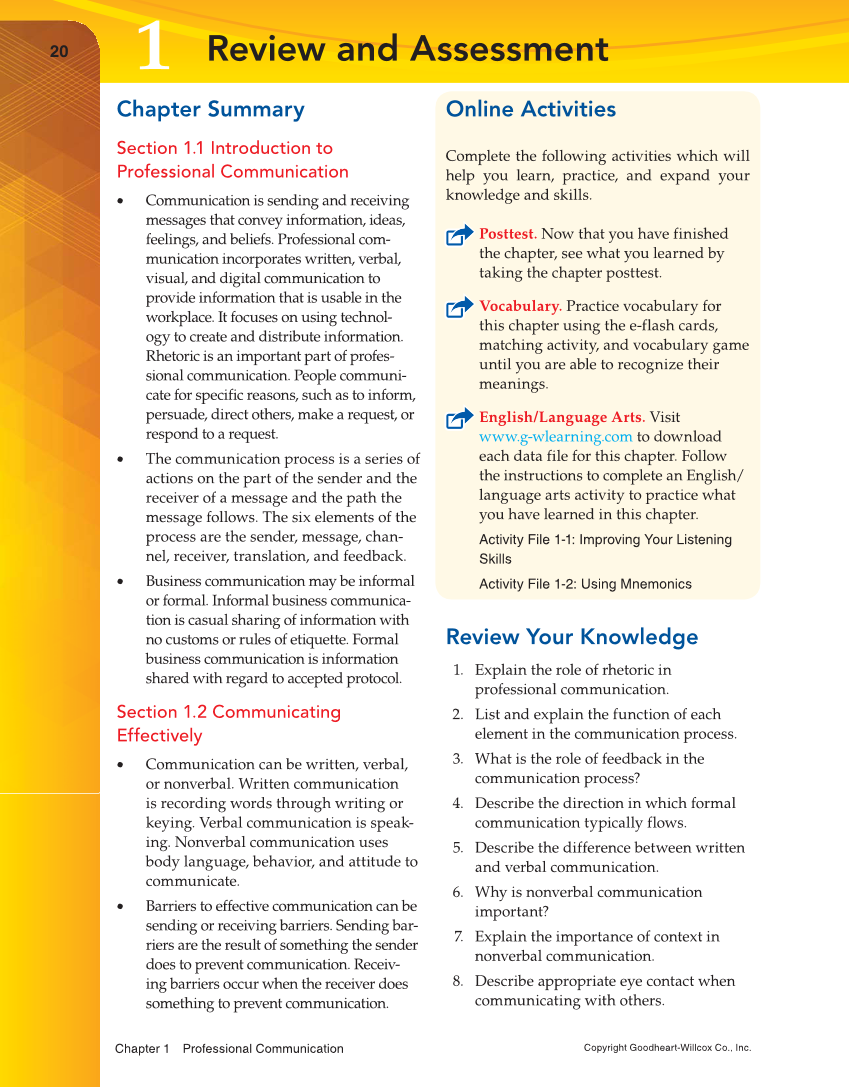Copyright Goodheart-Willcox Co., Inc. Chapter 1 Professional Communication 20 Review and Assessment 1 Chapter Summary Section 1.1 Introduction to Professional Communication • Communication is sending and receiving messages that convey information, ideas, feelings, and beliefs. Professional com- munication incorporates written, verbal, visual, and digital communication to provide information that is usable in the workplace. It focuses on using technol- ogy to create and distribute information. Rhetoric is an important part of profes- sional communication. People communi- cate for specific reasons, such as to inform, persuade, direct others, make a request, or respond to a request. • The communication process is a series of actions on the part of the sender and the receiver of a message and the path the message follows. The six elements of the process are the sender, message, chan- nel, receiver, translation, and feedback. • Business communication may be informal or formal. Informal business communica- tion is casual sharing of information with no customs or rules of etiquette. Formal business communication is information shared with regard to accepted protocol. Section 1.2 Communicating Effectively • Communication can be written, verbal, or nonverbal. Written communication is recording words through writing or keying. Verbal communication is speak- ing. Nonverbal communication uses body language, behavior, and attitude to communicate. • Barriers to effective communication can be sending or receiving barriers. Sending bar- riers are the result of something the sender does to prevent communication. Receiv- ing barriers occur when the receiver does something to prevent communication. Online Activities Complete the following activities which will help you learn, practice, and expand your knowledge and skills. Posttest. Now that you have finished the chapter, see what you learned by taking the chapter posttest. Vocabulary. Practice vocabulary for this chapter using the e-flash cards, matching activity, and vocabulary game until you are able to recognize their meanings. English/Language Arts. Visit www.g-wlearning.com to download each data file for this chapter. Follow the instructions to complete an English/ language arts activity to practice what you have learned in this chapter. Activity File 1-1: Improving Your Listening Skills Activity File 1-2: Using Mnemonics Review Your Knowledge 1. Explain the role of rhetoric in professional communication. 2. List and explain the function of each element in the communication process. 3. What is the role of feedback in the communication process? 4. Describe the direction in which formal communication typically flows. 5. Describe the difference between written and verbal communication. 6. Why is nonverbal communication important? 7. Explain the importance of context in nonverbal communication. 8. Describe appropriate eye contact when communicating with others.
